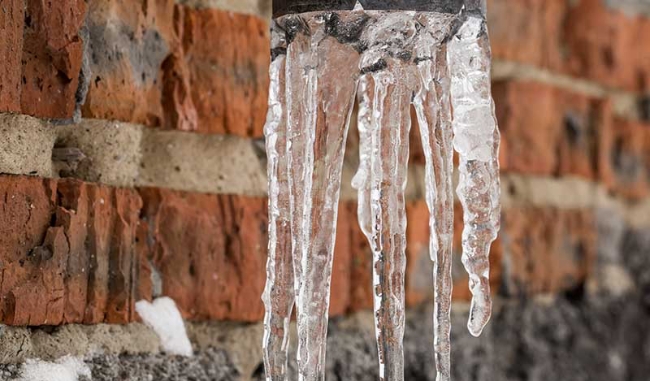We've uncovered this great article about How To Avoid Freezing Pipes down the page on the internet and figured it made good sense to relate it with you on this site.

Winter can wreak havoc on your plumbing, especially by freezing pipelines. Here's exactly how to stop it from taking place and what to do if it does.
Intro
As temperature levels decline, the risk of frozen pipes increases, potentially resulting in expensive repair work and water damage. Comprehending exactly how to prevent frozen pipes is crucial for homeowners in cold environments.
Avoidance Tips
Protecting vulnerable pipes
Cover pipes in insulation sleeves or make use of warmth tape to shield them from freezing temperatures. Focus on pipelines in unheated or external areas of the home.
Heating strategies
Keep interior areas adequately heated, especially areas with plumbing. Open cabinet doors to allow warm air to distribute around pipelines under sinks.
Just how to identify icy pipes
Seek lowered water circulation from taps, uncommon smells or noises from pipelines, and visible frost on exposed pipes.
Long-Term Solutions
Structural changes
Take into consideration rerouting pipes away from exterior walls or unheated areas. Add extra insulation to attics, basements, and crawl spaces.
Updating insulation
Invest in high-quality insulation for pipelines, attic rooms, and walls. Correct insulation assists maintain consistent temperature levels and decreases the risk of icy pipes.
Protecting Outside Plumbing
Yard pipes and outdoor taps
Disconnect and drain pipes garden pipes before wintertime. Install frost-proof spigots or cover exterior faucets with shielded caps.
Recognizing Frozen Pipes
What creates pipelines to freeze?
Pipelines ice up when exposed to temperatures listed below 32 ° F (0 ° C) for prolonged durations. As water inside the pipelines freezes, it expands, putting pressure on the pipe wall surfaces and potentially creating them to rupture.
Risks and damages
Frozen pipelines can lead to water disturbances, home damage, and expensive repairs. Burst pipes can flood homes and create comprehensive structural damage.
Indicators of Frozen Piping
Identifying frozen pipes early can avoid them from rupturing.
What to Do If Your Pipes Freeze
Immediate actions to take
If you believe icy pipes, maintain taps open to alleviate stress as the ice melts. Use a hairdryer or towels taken in hot water to thaw pipelines slowly.
Verdict
Avoiding icy pipes calls for proactive actions and quick actions. By understanding the reasons, indicators, and safety nets, homeowners can secure their pipes during cold weather.
6 Proven Ways to Prevent Frozen Pipes and Protect Your Home
Disconnect and Drain Garden Hoses
Before winter arrives, start by disconnecting your garden hoses and draining any remaining water. Close the shut-off valves that supply outdoor hose bibs and leave the outdoor faucet open to allow any residual water to drain. For extra protection, consider using faucet covers throughout the colder months. It’s also important to drain water from any sprinkler supply lines following the manufacturer’s directions.
Insulate Exposed Pipes
Insulating your pipes is an effective way to prevent freezing. Pipe insulation is readily available at home improvement stores and is relatively inexpensive. Pay close attention to pipes in unheated areas such as the attic, basement, crawl spaces, or garage. Apply foam insulation generously to create a buffer against the cold. You can also wrap your pipes in heat tape or thermostat-controlled heat cables for added warmth.
Seal Air Leaks
Inspect your home for any cracks or openings that could let in cold air. Seal any holes around the piping in interior or exterior walls, as well as the sill plates where your home rests on its foundation. Additionally, make sure to keep your garage door closed unless you’re entering or exiting. Leaving it open creates a significant air leak that can lead to frozen pipes.
Allow Warm Air Circulation
During cold snaps, it’s essential to allow warm air to circulate evenly throughout your home. Leave interior doors ajar to promote better airflow. Open kitchen and bathroom cabinets to help distribute heat consistently around the rooms. If you have small children or pets, be sure to remove any household chemicals or potentially harmful cleaners from open cabinets for safety.
Let Faucets Drip
A small trickle of water can make a big difference in preventing ice formation inside your pipes. When temperatures drop significantly, start a drip of water from all faucets served by exposed pipes. This continuous flow helps prevent the water from freezing. Additionally, running a few faucets slightly can relieve pressure inside the pipes, reducing the chances of a rupture if the water inside does freeze.
https://choateshvac.com/6-proven-ways-to-prevent-frozen-pipes-and-protect-your-home/

I hope you enjoyed our section about Winter Plumbing Precautions: Preventing Frozen Pipes. Thanks a lot for taking the time to browse our short article. Sharing is nice. You never know, you could be doing someone a favor. I take joy in reading our article about How to prepare your home plumbing for winter weather.
Detail